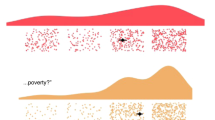Abstract
Rising income inequality in the 1990s was used to examine the links between micro- and macro-justice. Data from a sample of 119 managers and 334 union members supported our hypothesis that those who more strongly endorsed equality norms at the micro-justice level perceived macro-level income inequality as more unjust. Looking at two key subgroups, our hypothesis that union members were more likely than managers to endorse an equality norm was not supported. Yet managers were significantly more likely than union members to endorse an equity norm at the micro level, as predicted. Finally, our fourth hypothesis that the equality norm mediates the relationship between union membership and perceived injustice was not supported.
Similar content being viewed by others
References
AFL-CIO Committee on Evolution of Work. (1985 February). A Report—The Changing Situation of Workers and Their Unions. p. 28. Washington: DC.
Arts, W., Hermkens, P., & Van Wijck, P. (1991). Income and the idea of justice: Principles, judgments, and their framing. Journal of Economic Psychology, 12, 121–140.
Bentler, P. M., & Chou, C. P. (1987). Practical issues in structural modeling. Sociological Methods and Research, 16, 78–117.
Bernstein, J., & Mishel, L. (1999). Strong income growth, falling poverty rates in ‘98, Yet inequality unchanged. Economic Policy Institute Income Fax, 1.
Bernstein, J., McNichol, E.C., Mishel, L., & Zahradnik, R. (2000). Pulling Apart: A State-By-State Analysis of Income Trends. Washington, DC: Center on Budget and Policy Priorities, Economic Policy Institute.
Boomsma, A. (1982). The robustness of LISREL against small sample sizes in factor analysis models. In Joreskog, K. G., & Wold, H. (Eds.), Systems Under Indirect Observation: Causality, Structure and Prediction, Part I. Amsterdam: North-Holland.
Brickman, P., Folger, R., Goode, E., & Schul, Y. (1981). Micro-justice and Macro-justice. In Lerner, M. J., & Lerner, S. C. (Eds.), The Justice Motive in Social Behavior: Adapting to Times of Scarcity and Change, 173–204. New York: Plenum Press.
Chen, C. C. (1995). New Trends in Reward Allocation Preferences: A Sino-U.S. Comparison. Academy of Management Journal, 38, 408–428.
D’Anjou, L., Steijn, A., & Van Aarsen, D. (1995). Social Position, Ideology, and Distributive Justice. Social Justice Research, 8, 351–384.
Deery, S., & Walsh, J. (1999). The decline of collectivism? A comparative study of white-collar employees in Britain and Australia. British Journal of Industrial Relations, 37, 245–269.
Dornstein, M. (1991). Conceptions of Fair Pay: Theoretical Perspectives and Empirical Research. New York: Praeger Publishers.
Ehrenreich, B. (2001). Nickeled and Dimed: On (Not) Getting by in America. NY: Metropolitan Books.
Frege, C. M. (1997). Does economic transformation undermine union collectivism? The case of East German textile workers. Industrial Relations Journal, 28, 163–175.
Geary, J. F. (1993). A new collectivism or trade union marginalization?: The role of trade unions in the introduction of New Work structures. Management Research News: MRN, 16, 57–58.
Hester, L. M. (1997). “The Influence of Family Socialization, Individual Work Beliefs and Orientation on Union Commitment and Union Participation.” Unpublished Ph.D. Dissertation, University of Alabama.
Homans, G. C. (1982). Introduction. In Greenberg, J., & Cohen, R. L. (Eds.), Equity and Justice in Social Behavior, xi–xviii. New York: Academic Press.
Hui, C. H., Triandis, H. C., & Yee, C. (1991). Cultural differences in reward allocation: Is Collectivism the explanation? British Journal of Social Psychology, 30, 145–157.
Hurd, R. W. (1998). Contesting the Dinosaur image: The labor movement’s search for a future. In Neufeld, M. F., McKelvey, J. T., & Zamoiski, P. (Eds.), Industrial Relations at the Dawn of the New Millennium, 127–144. Cornell University: New York State School of Industrial and Labor Relations.
Jasso, G. (1983). Fairness of individual rewards and fairness of the reward distribution: Specifying the inconsistency between the micro and macro principles of justice. Social Psychology Quarterly, 46, 185–199.
Klandermans, B., Roefs, M., & Olivier, J. (2001). Grievance formation in a country in transition: South Africa, 1994–1998. Social Psychology Quarterly, 64, 41–54.
Kochan, T. A., Katz, H. C., & McKersie, R. B. (1994). The Transformation of American Industrial Relations. Ithaca, NY: ILR Press.
Levanthal, G.T., Karuza, J., & Fry, W.R. (1980). Beyond fairness: A theory of allocation preferences. In Macula, G. (Ed.), Justice in Social Interaction, 166–218. New York: Springer-Verlag.
Leung, K. (1988). Theoretical Advances in Justice Behavior: Some Cross-Cultural Inputs. In Harris, M. (Ed.), The Cross-Cultural Challenge to Social Psychology, 218–229. Bond. Newberry Park, CA: Sage.
Lucio, M. M., & Stewart, P. (1997). The paradox of contemporary labour process theory: The rediscovery of labour and the disappearance of collectivism. Capital & Class, 62, 49–77.
Markovsky, B. (1985). Toward a multi-level distributive justice theory. American Sociological Review, 50, 822–839.
Marsh, H. W., Balla, J. R., & McDonald, R. P. (1988). Goodness of fit indexes in confirmatory factor analysis: The effect of sample size. Psychological Bulletin, 103, 391–410.
Martin, J. (1992). “Inequality, Distributive Injustice, and Organizational Illegitimacy.” Working Paper, Graduate School of Business, Stanford University. Stanford, CA.
Mikula, G. (1980). On the Role of Justice in Allocation Decisions. In Mikula, G. (Ed.), Justice and Social Interaction, 67–217. New York and London: Plenum.
Mikula G., & Schwinger, T. (1978). Intermember Relations and Reward Allocation. In Brandstatter, H., Davis, J. H., & Schuler, H. (Eds.), Dynamics of Group Decision, 229–250. Beverly Hills: Sage.
Reingold, J., & Grover, R. (1999). Executive Pay: Special Report. Business Week, 3625, 72–90.
Tornblom, K. Y., & Foa, U. G. (1983). Choice of a Distribution Principle: Cross-Cultural Evidence on the Effects of Resources. Acta Sociologica, 26, 161–173.
Triandis, H. C. (1989). Cross-Cultural Studies of Individualism and Collectivism. In Berman, J. (Ed.), The Nebraska Symposium on Motivation, 41–133. Lincoln, NE: University of Nebraska Press.
Author information
Authors and Affiliations
Corresponding author
Rights and permissions
About this article
Cite this article
Simpson, P.A., Kaminski, M. Rising Income Inequality in a Time of Plenty: The Influence of Micro-Justice Standards and Group Membership on Macro-Justice Perceptions. Employ Respons Rights J 17, 47–61 (2005). https://doi.org/10.1007/s10672-005-1813-z
Issue Date:
DOI: https://doi.org/10.1007/s10672-005-1813-z




